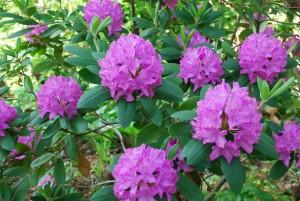Renewal pruning is the practice of severely cutting back selected shrubs and trees. The task is simple. There are no books to read. Select a day from mid-February to early April (USDA hardiness zones 5-7). Cutback the entire shrub(s), leaving 3-5 inch tall cut stems or stubble. The cut stems will bud out in the spring along with adventitious buds below the soil line.
Renewal pruning can eliminate weather-damaged, diseased, and insect-riddled wood, particularly scale insects, without resorting to heavy pesticide use. All diseased and pest-ridden prunings should be removed from the property or burned. Healthy pruning wood can be ground up for mulch that is spread after 6 months or more composting.
Renewal pruning invigorates old shrubs, brightens foliage color, and increases fruit size and quality. Pruning tools needed: hand clippers, loppers, hand pruning saw, or chain saw. Do not use string trimmers (“weed-eaters”).
Renewal pruning may not the ideal practice for all shrubs.
• Summer flowering shrubs often recover and bloom the same year. Some spring flowering shrubs may not re-bloom for 1-2 years.
• Overgrown rhododendrons, hollies, pieris and mountain laurels respond better to a practice called “coppicing” in late September or early October in USDA hardiness zones 5-7.
• Plant health must be good. Weak, sickly shrubs may likely die when drastically cutback.
• Shrubs must be well-established for 3 to 4 years before renewal cutback.
• Don’t cutback grafted or budded plants in fear of losing the cultivar (above-ground portion) The root system may gain dominance.
Partial list of shrubs which respond to renewal pruning:
Glossy abelia (Abelia x grandifolia)
Butterfly bush (Buddleia davidii)
Beautyberry (Callicarpa spp.)
Blue mist shrub (Caryopteris x clandonensis)
Smoke tree (Cotinus coggygria)
Forsythia (Forsythia spp.)
Fothergilla (Fothergilla spp.)
Rose of Sharon (Hibiscus syriacus)
Smooth hydrangea (Hydrangea arborescens)
Pee Gee hydrangea (Hydrangea paniculata ‘Grandifolia’)
Oakleaf hydrangea (Hydrangea quercifolia)
Crape myrtle (Lagerstroemia indica x L. faurei)
Trumpet honeysuckle (Lonicera sempervirens)
Firethorn (Pyracantha spp.)
Sumac (Rhus spp.)
Rugosa rose (Rosa rugosa)
Pussy willow (Salix spp.)
Corkscrew willow (Salix matsudana)
Elderberry (Sambucus canadensis)
‘Hancock’ coralberry (Symphoricarpus orbiculatus ‘Hancock’)
Chaste tree (Vitex agnus-castus)
Weigela (Weigela florida)


 Posted in
Posted in 
